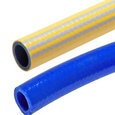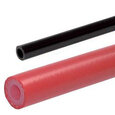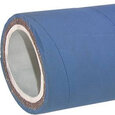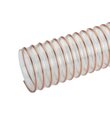How To Clean a Food-Grade Hose
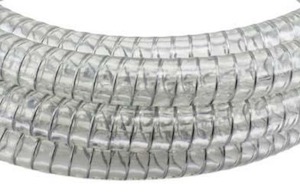
Figure 1: Food-grade PVC hose
Regularly cleaning food-grade hoses is essential for maintaining the quality and safety of food-related applications. Following the recommended cleaning procedures and schedules ensures the longevity of hoses, prevents contamination, and meets regulatory requirements. This article explores the importance of cleaning food-grade hoses, how to clean them, and some maintenance tips. Read our food-grade hose guide article for more information on the features and benefits of food-grade hoses, their materials, certifications, and applications.
View our online selection of food-grade and other hoses!
What is a food-grade hose?
Food-grade hoses are specially designed to meet stringent hygiene and safety standards for food-related applications. These hoses are made from non-toxic, odorless materials and resist the chemicals commonly found in food and beverages. Common materials like silicone, PVC, and rubber compounds are used to construct food-grade hoses; these materials are flexible, durable, and easy to clean.
Food-grade hoses are distinguishable from standard hoses by several key features.
- Food-grade hoses are typically transparent or have a light-colored outer cover, allowing for easy visual inspection of the transferred fluid.
- Food-grade hoses have smooth inner surfaces that minimize the risk of bacteria growth and facilitate thorough cleaning.
Applications
Food-grade hoses are vital in multiple industries, including water treatment, breweries, wineries, and beverage production. They are essential for transporting fluids in heating and cooling systems, facilitating liquid transfer in processing and packaging lines, and in agriculture and manufacturing for irrigation, fertilizers, pesticides, and ingredient conveyance in food processing, pharmaceutical production, and cosmetics.
Cleaning food-grade hoses
Regular cleaning of food-grade hoses is crucial for maintaining the quality and safety of food-related applications. Failure to do so can lead to the growth of bacteria, mold, and other contaminants, compromising the integrity of the transferred fluids. Proper cleaning also prevents cross-contamination between different batches of food products, preserving their taste, appearance, and shelf life.
When to clean
It's recommended to clean the food-grade hose after every use or at least once a month. To ensure hygiene, it's important to recognize when a food-grade hose requires cleaning. Here are some signs that indicate it's time to clean your hose:
- Foul odor or taste in the fluid: Noticing an unpleasant odor or an off-flavor in the fluid being transferred is a clear indicator of potential contamination.
- Visible debris or discoloration: Any visible particles, stains, or discoloration on the inner or outer surface of the hose should prompt immediate cleaning.
- Reduced flow rate: Accumulating deposits or blockages within the hose can restrict the flow and increase pressure, affecting the system's efficiency.
How to clean
Cleaning before first use
Recently purchased food-grade hoses might have a slight odor due to the manufacturing process. Follow these steps before using the hose for the first time:
- Fill the hose with hot water.
- Keep the water inside the hose for at least 10 hours.
- Empty the hose.
Regular cleaning
Follow these steps to effectively clean a food-grade hose regularly:
-
Disconnect the hose:
- Wear appropriate protective gear like gloves and goggles to ensure personal safety.
- Start by disconnecting the hose from the system and ensuring all valves are closed. Follow the manufacturer's instructions for disassembly. Some hoses may have removable fittings or connectors that must be detached before cleaning.
- Prepare a cleaning solution by diluting a food-grade hose cleaner per the manufacturer's instructions.
- Flush the hose with clean water: Use a clean water source to flush the hose thoroughly, removing any loose particles or residue. Allow the water to flow through the hose until it runs clear.
- Soak the hose in the cleaning solution: Immerse the food-grade hose in the prepared cleaning solution. Ensure that the entire length of the hose is submerged, and allow it to soak for the recommended duration, typically around 30 minutes. Tables 1 and 2 give details about water-based and chemical-based cleaning solution options for food-grade hoses.
Note: Please ensure the cleaning solution is compatible with the food-grade hose by referring to our chemical compatibility chart. Also, refer to the hose manufacturer's guidelines for the cleaning solutions suitable for the particular application.
Table 1: Water-based cleaning options for food-grade hoses
| Cleaning agents | Temperature | Duration |
| Water | 90 𐩑C (194 𐩑F) | Maximum 20 minutes |
| Steam | 130 𐩑C (266 𐩑F) | Maximum 20 minutes |
Table 2: Chemical-based cleaning options for sanitary hoses
| Chemicals | Temperature | Duration |
| Caustic Soda (NaOH) | 2% at room temperature | Maximum 30 minutes |
| Hydrogen Peroxide (H202) | 0.15% at room temperature | Maximum 30 minutes |
| Nitric Acid (HNO3) | 0.15% at room temperature | Maximum 30 minutes |
- Rinse the hose: After soaking, remove the cleaning solution from the hose and rinse it thoroughly with clean water. Ensure that all traces of the cleaning solution are removed.
-
Dry and store the hose properly:
- Hang the hose vertically to allow for proper drying.
- Ensure the hose is completely dry before reconnecting or storing it to prevent mold or mildew growth.
- Store the hose in a clean, dry area away from direct sunlight and potential contaminants.
Additional cleaning tips
- Use a soft brush or sponge with gentle scrubbing to remove stubborn stains or persistent odors.
- Repeat the cleaning process with the food-grade hose cleaner, or consider using a specialized enzymatic cleaner for tough stains.
Cleaning and maintenance recommendations
Establish a regular cleaning and maintenance schedule based on the specific application, fluid type, and environmental conditions. In most cases, cleaning food-grade hoses at least once a month is recommended or more frequently if contamination is observed. Regularly inspect the hose for any signs of wear, cracks, or damage, and replace it if necessary to ensure optimal performance and safety.
FAQs
How often should I clean my food-grade hose?
Clean the hose after every use, at least once a month, or when signs of contamination are observed.
Can I use any cleaning solution for my food-grade hose?
Use cleaning solutions specifically formulated for food-grade hoses that meet food safety standards. Avoid using harsh chemicals or abrasive cleaners that can damage the hose or leave harmful residues.




